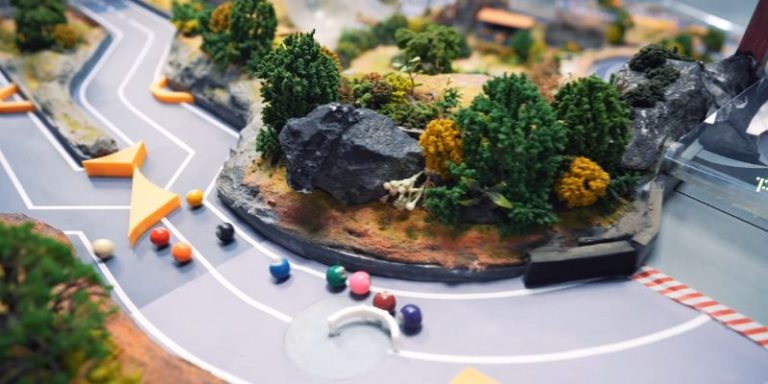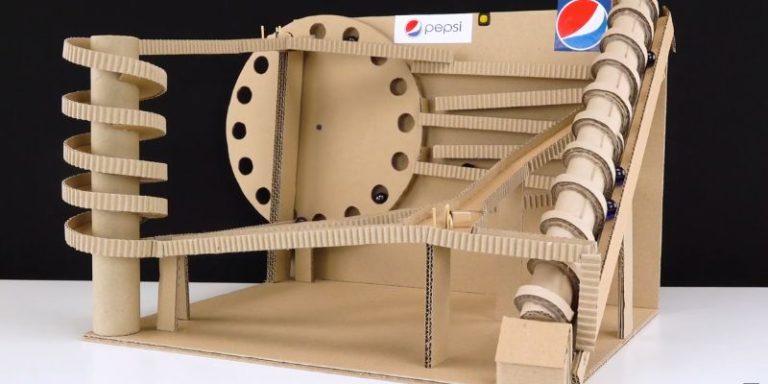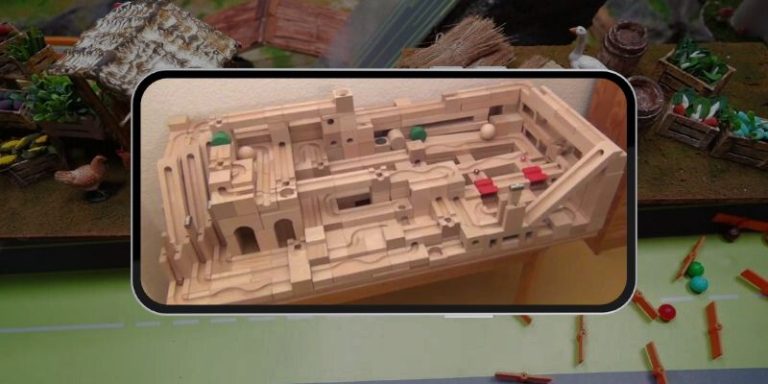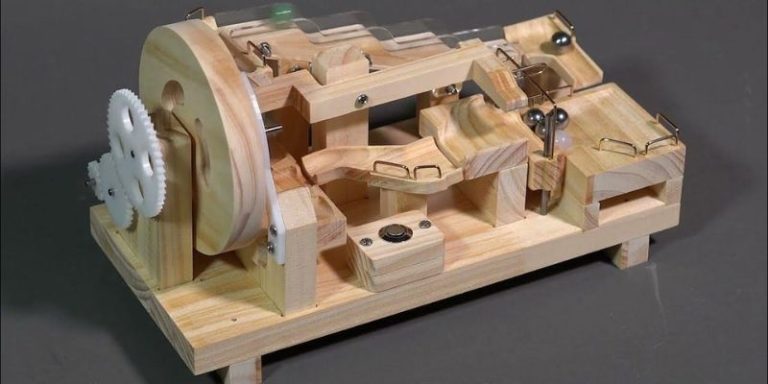Specialty track brings new challenges to marble racing
Specialty tracks are a standout feature in the world of marble racing, designed to bring unique challenges and excitement to the sport. Unlike standard tracks, specialty tracks are tailored with customized designs and specialized features that cater to specific racing goals, such as speed trials, obstacle courses, or themed competitions.
They often include innovative elements like multi-level paths, moving parts, or intricate obstacles that test both the skill of racers and the adaptability of their marbles. The distinctive designs make them perfect for one-of-a-kind events, themed tournaments, or advanced setups that push the boundaries of marble racing.
What makes a track specialty?
A specialty track stands apart from traditional marble racing tracks due to its unique features and tailored designs, which cater to specific challenges and experiences. These are not meant for everyday use but are created for special events, experiments, or themed competitions that demand something extraordinary.
Unique features
Specialty tracks often include rare or innovative elements that elevate the racing experience.
- Jump sections: These add excitement by requiring marbles to leap over gaps, testing their momentum and trajectory.
- Multi-level paths: Intersecting or overlapping levels create visual complexity and demand strategic planning.
- Moving parts: Incorporating spinning wheels, shifting barriers, or rotating platforms introduces unpredictability, making races more dynamic.
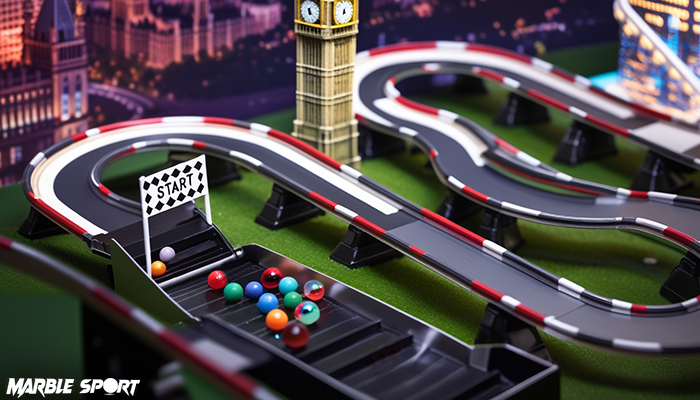
These features make specialty tracks challenging for racers and thrilling for spectators.
Custom designs
Specialty tracks are built to serve a specific purpose, offering designs that go beyond the capabilities of standard tracks.
- Speed-focus runs: Steep slopes and straight paths maximize marble velocity.
- Obstacle-heavy courses: Packed with barriers, tunnels, and sharp to test a marble’s ability to navigate difficult terrain.
- Themed design: Icy paths for winter races or futuristic tunnels for sci-fi events.
These customizations allow specialty tracks to cater to unique racing styles and creative concepts.
Limited use cases
Unlike standard tracks, which are versatile and reusable, specialty designs are often created for specific occasions
- One-time events: Built for tournaments, exhibitions, or milestone celebrations.
- Experimental races: Used to test new racing features, such as different marble materials or track dynamics
- Showcase tracks: Designed to highlight innovation and creativity in marble racing design.
The highly specialized nature makes these tracks less common but far more impactful when used.
Specialty tracks bring a level of innovation and creativity to marble racing that standard ones can’t match. By combining unique features, custom designs, and specific use cases, they add variety, challenge, and excitement to the sport, making them a key part of memorable racing experiences.
Popular types of specialty tracks
Specialty tracks come in various forms, each tailored to bring a unique challenge or thrill to marble racing. These tracks are carefully designed to test specific skills, enhance competition, or create memorable racing experiences. Here are some of the most popular types of specialty courses:
Speed track
Speed tracks focus entirely on achieving the fastest times possible, pushing marble to its limit
- Key features: Steep slopes, smooth surfaces, and streamlined paths designed to maximize velocity
- Applications: Used primarily in time trials or high-speed competitions, where precision and speed are paramount.
- Spectator appeal: The adrenaline rush of watching marbles zip through these tracks makes them a crowd favorite.
Speed tracks highlight the importance of momentum and acceleration, making every second count.
Obstacle courses
Obstacle courses bring a layer of complexity and skill to marble racing by introducing physical challenges.
- Key features: Barriers, jumps, spirals, and tight turns that test a marble’s adaptability and momentum.
- Applications: Often featured in events emphasizing strategy and control, where racers need to navigate the course with precision.
- Spectator appeal: The unpredictable nature of these tracks keeps the audience on edge as marbles overcome each hurdle.
These courses emphasize the versatility of marbles and the creativity of track designs.
Multi-level tracks
Multi-level tracks add a dimensional aspect to marble racing by incorporating different heights and intersecting paths.
- Key features: Ramps, bridges, and overlapping sections create a visually complex and challenging environment.
- Applications: Perfect for exhibition events or competitions where visual impact matters as much as performance.
- Spectator appeal: The layered design adds depth and excitement, making races more engaging to watch.
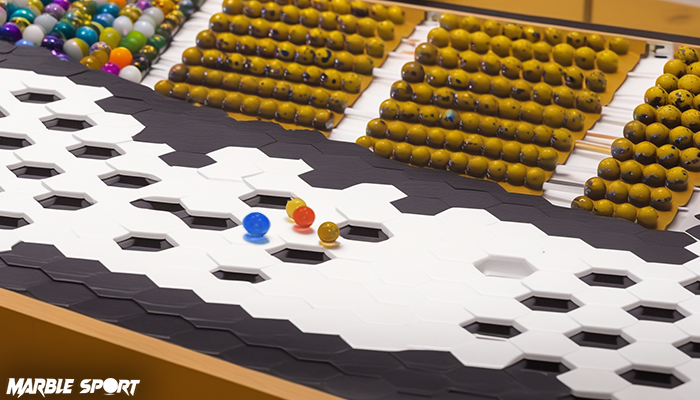
These tracks challenge racers to maintain speed and control across varying levels of elevation.
Themed specialty tracks
Themed tracks take creativity to the next level by incorporating narrative-driven elements into the racing experience.
- Key features: Custom elements like water features, icy surfaces, or futuristic tunnels that align with a specific theme.
- Application: Popular in themed tournaments or special events, where the focus is on blending creativity with competition
- Spectator appeal: The immersive visuals and unique challenges captivate the audience, making every race feel like an adventure.
Themed tracks transform marble racing into an art form, combining storytelling and engineering for a one-of-a-kind experience.
By exploring different types of specialty tracks, marble racing enthusiasts can enjoy a variety of challenges and thrills. Whether it’s the blazing speed of steep slopes, the technical skill required for obstacle courses, or the creativity or themed designs, specialty tracks add endless possibilities to the sport.
The role of specialty tracks in marble racing
Specialty tracks play a pivotal role in advancing the excitement, innovation, and engagement of marble racing. The unique designs and specialized features make them essential for delivering dynamic racing experiences that captivate both racers and spectators. Here’s how specialty tracks contribute to marble sport.
Event highlights
Specialty tracks are often the main attraction in major marble racing events, serving as the centerpiece for tournaments and exhibitions.
- Unique designs: The innovative layouts and creative themes make events feel fresh and exciting.
- Memorable experiences: Specialty tracks turn regular races into standout moments, leaving lasting impressions on fans and participants.
- Showcasing creativity: They allow event organizers to showcase the best in track design and engineering.
These tracks are designed to elevate the overall event experience, turning races into must-watch spectacles.
Testing ground for innovation
Specialty tracks are the perfect environment for testing new ideas and pushing the boundaries of marble racing design.
- Experimental features: They introduce new obstacles, mechanics, and race formats that may not fit into standard tracks.
- Material testing: Specialty tracks allow for the trial of different materials or track components before they’re used in competitive settings.
- Rule development: Racing organizations can experiment with new rules and formats on specialty tracks to improve the sport.
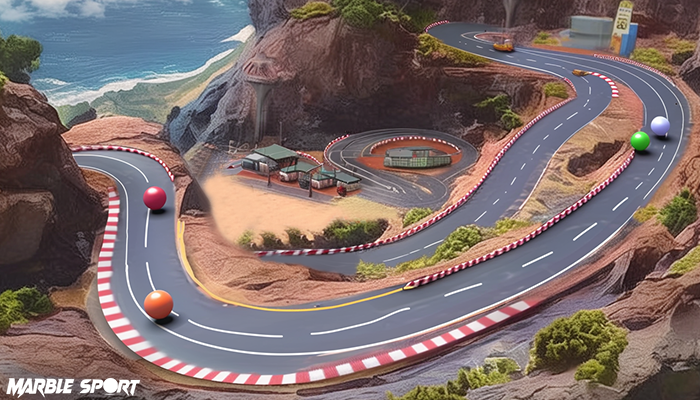
This experimental nature keeps the sport evolving, making specialty tracks a hub for innovation and creativity.
Engagement and spectator appeals
Specialty tracks are built to captivate and engage audiences with visually impressive and challenging layouts.
- Exciting visuals: Bold themes, intricate designs, and interactive features grab attention and build excitement.
- Unpredictability: Unique obstacles and layouts introduce more suspense, making races less predictable and more thrilling.
- Storytelling: Themed specialty tracks can tell a story, creating a deeper connection between the race and the audience.
This level of engagement keeps spectators coming back, increasing viewership and fan interaction with the sport.
By offering memorable race moments, serving as a testing ground for new ideas, and keeping audiences engaged and entertained, specialty tracks play a crucial role in driving the growth and popularity of marble racing. They push the sport beyond traditional racing, delivering experiences that are both competitive and creatively fulfilling.
Challenges of specialty tracks
While specialty tracks bring innovation and excitement to marble racing, they also come with specific challenges. From design complexity to higher costs, these tracks demand more effort and resources are crucial for anyone considering building or implementing specialty tracks.
Design complexity
Specialty tracks require advanced planning and precision to function properly.
- Intricate layouts: Complex features like multi-level paths, moving parts, or interactive obstacles must be carefully designed to ensure smooth marble flow.
- Balancing creativity and functionality: Overly elaborate designs can disrupt race performance if not properly balanced with the track’s core mechanics.
- Testing and adjustment: Specialty tracks often need multiple rounds of testing and fine-tuning to guarantee consistent and fair races.
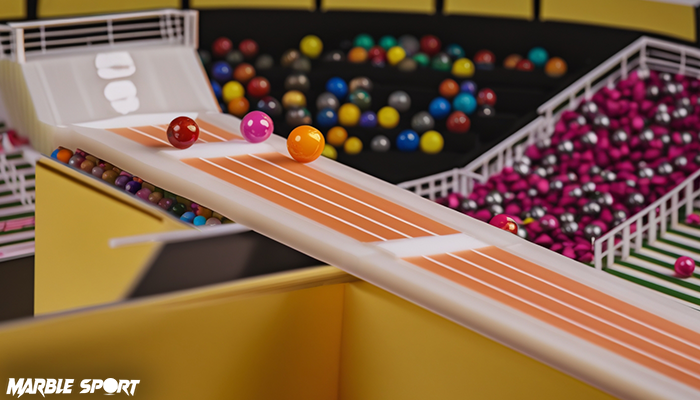
Without careful planning, specialty tracks risk becoming more frustrating than fun, both for racers and spectators.
High costs
Building a specialty track is typically more expensive than constructing a standard track.
- Specialized materials: Premium materials like custom-molded plastic, wood, or mechanical parts increase production costs.
- Custom features: Unique obstacles, decorative elements, and moving components can be costly to design and build.
- Maintenance expenses: Specialty tracks often require upkeep or repairs, adding long-term costs.
For event organizers or hobbyists, the financial investment can be significant, making specialty tracks a choice for larger-scale events or serious enthusiasts.
Limited use
Specialty tracks are often designed for specific events or race types, which limits their versatility.
- Single-purpose design: A layout built for a specific theme or challenge may not be suitable for general racing.
- Storage and setup: Larger or more complex specialty tracks can be difficult to store and time-consuming to set up.
- Adaptability: Unlike modular standard tracks, specialty tracks may not easily adapt to different race formats and themes.
Because of these limitations, specialty tracks are typically used for one-off events or special competitions rather than regular racing.
Despite the challenges, specialty tracks continue to be a cornerstone of innovation in marble racing. With careful planning, budgeting, and creativity, the obstacles can be managed, resulting in tracks that provide unmatched excitement and engagement.
Benefits of specialty tracks
Specialty tracks offer numerous advantages that make them a valuable part of marble racing. The ability to introduce fresh challenges and captivating designs sets them apart from standard tracks, enhancing both the racing experience and audience engagement.
Excitement and variety
Specialty tracks inject much-needed excitement and variety into marble racing by breaking the routine of standard track designs.
- Unique challenges: With creative features like jumps, multi-level sections, and moving obstacles, every race feels fresh and unpredictable.
- Dynamic race conditions: Specialty tracks test a marble’s speed, adaptability, and stability, adding new layers of strategy and competition.
- Unforgettable experiences: The unpredictability and creativity of these tracks ensure each race is a memorable event for both racers and fans.
This variety keeps marble racing engaging and encourages racers to adapt to different racing conditions.
Innovation
Specialty tracks are a driving force for innovation in marble racing, constantly pushing the sport forward.
- Creative freedom: Builders and designers can explore bold ideas, leading to groundbreaking track features and race mechanics.
- Advanced engineering: Incorporating elements like moving parts or themed obstacles challenges designers to balance creativity with functionality.
- New race format: Specialty tracks often inspire new types of races, from obstacle-heavy sprints to themed adventure courses.
By encouraging out-of-the-box thinking, specialty tracks help expand the boundaries of that’s possible in marble racing.
Spectator appeal
Specialty tracks are designed to captivate and entertain, making them a crowd favorite at events.
- Visually stunning designs: Bright colors, intricate layouts, and interactive features make races more engaging to watch.
- Themed experiences: Tracks that follow specific themes – like space adventures or jungle runs – offer an immersive and entertaining experience.
- Thrilling elements: Unpredictable obstacles and dynamic layouts keep spectators on the edge of their seats.
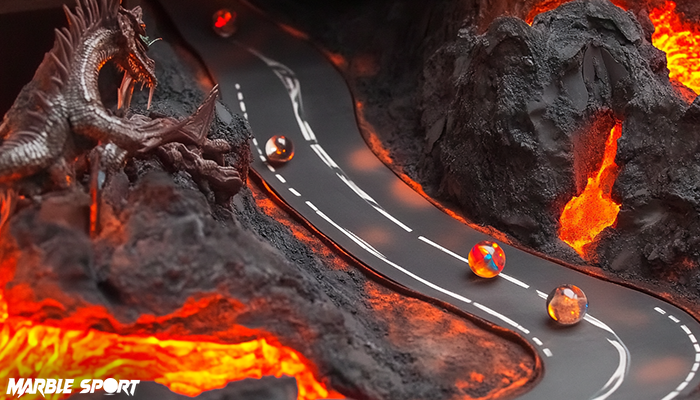
This high level of spectacle and excitement attracts larger audiences and builds stronger fan engagement.
Specialty tracks offer a perfect blend of innovation, excitement, and visual appeal, making them a cornerstone of modern marble racing. They challenge racers, inspire designers, and captivate audiences, ensuring that every event is as thrilling and engaging as possible.
Examples of specialty tracks in real events
Specialty tracks have gained significant attention in professional marble racing and creative showcases due to their unique designs and engaging features. From professional leagues to educational environments, specialty tracks have been used to push the limits of what marble racing can offer. Here are some real-world examples where specialty tracks have truly shined.
Jelle’s marble runs
One of the most popular examples of specialty tracks in action comes from Jelle’s Marble Runs, a leading name in professional marble racing.
- Innovative designs: Jelle’s event features tracks with jump sections, tunnels, split paths, and themed obstacles, challenging racers with creative and unpredictable layouts.
- Event highlights: Specialty tracks are often the centerpiece of special tournaments like the Marble League or Marbula One, elevating the excitement with unique race conditions.
- Fan engagement: These tracks not only test the marbles but also captivate global audiences with their thrilling and intricate designs.
Jelle’s marble runs continue to set the standard for how specialty tracks can transform marble racing into a global phenomenon.
Custom exhibitions
Specialty tracks are also popular in custom exhibitions and events designed to showcase creativity and engineering.
- Limited-time event: Custom-built tracks are often created for exclusive competitions or exhibitions, offering one-of-a-kind racing experiences.
- Theme integration: These tracks frequently feature elaborate themes – such as pirate ships, mountain climbs, or futuristic landscapes – blending entertainment with racing.
- Interactive features: Builders often incorporate elements like moving parts, mechanical lifts, or complex obstacle systems to make the races even more engaging.
Costume exhibitions allow designers to experiment freely and bring bold ideas to life without the constraints of standard racing formats.
Educational setups
Beyond entertainment, specialty tracks have found a place in educational settings, where they are used as interactive learning tools.
- STEM learning: Used in schools to demonstrate concepts like physics, engineering, and motion through hands-on activities.
- Problem-solving skills: Students design and build tracks, learning about gravity, momentum, friction, and structural design.
- Workshops and competitions: Educational programs often host track-building workshops and competitions, encouraging creativity and teamwork.
These setups show how specialty tracks can be more than entertainment – they can also serve as powerful educational tools that inspire innovation and learning.
Whether it’s a professional league like Jelle’s Marble Runs, custom exhibitions, or educational programs, specialty tracks continue to showcase the endless possibilities of marble racing. Their innovative designs and unique challenges not only enhance competition but also inspire creativity and engagement in racers and spectators alike.
